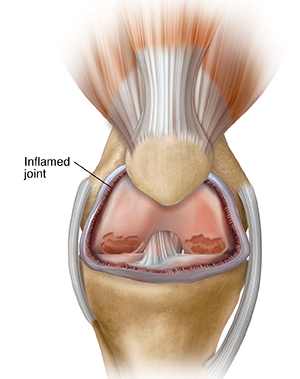Content
Understanding Psoriatic Arthritis
Psoriatic arthritis is joint pain and swelling that occurs in some people who have psoriasis. Psoriasis is a skin disease that causes scaly skin patches. People who have psoriasis may develop psoriatic arthritis later. In some cases, psoriatic arthritis develops before psoriasis.
How to say it
sor-ee-A-tik arthritis
What causes psoriatic arthritis?
Doctors don't know the exact cause of psoriatic arthritis. But it's linked to problems with the body’s infection-fighting system (immune system). Other factors include:
Family history. People who have psoriatic arthritis often have relatives with either psoriasis or arthritis, or both.
Certain infections. These include strep infections and HIV.
Environment. Stress, injury to skin, and certain medicines may trigger psoriasis to become active.
What are the symptoms of psoriatic arthritis?
Symptoms may include:
Pain, tenderness, and swelling in any joint, including the spine
Joint or back stiffness, especially in the morning
Patches of rough skin that are usually red underneath and scaly and white or silver on top
Fingernail problems, such as pitted, or crumbly nails, or nails that are detached from the nail bed
Pain and swelling where muscles attach to bones
Swelling of fingers or toes
Eye redness or inflammation
How is psoriatic arthritis treated?
Psoriatic arthritis doesn't go away. It's a long-term (chronic) condition that needs long-term treatment. Medicines are an important part of treatment. These medicines are often used:
Prescription or over-the-counter pain medicines to help reduce swelling and pain
Prescription medicines that limit the effect of the immune system. They may reduce or prevent joint damage. Methotrexate is a pill commonly used. Biologic and targeted synthetic medicines and skin patches may also be used to treat psoriatic arthritis.
Steroid injections in affected joints to help ease symptoms
Topical medicines for rough skin patches to ease discomfort and dryness
In addition to medicines, these treatments may be recommended:
Regular exercise to improve flexibility and strength
Physical therapy to help ease pain and improve flexibility
Heat packs to help ease pain and swelling
Shoe inserts to keep your feet and ankles stable, and to help with foot pain
What are the complications of psoriatic arthritis?
Possible complications include:
Joint damage that gets worse
Reduced ability to use affected joints
When should I call my healthcare provider?
Call your healthcare provider right away if any of the following occur:
You have a fever of 100.4°F (38°C) or higher, or as directed by your healthcare provider
You have pain that gets worse
You have symptoms that don’t get better, or symptoms that get worse
You develop new symptoms


